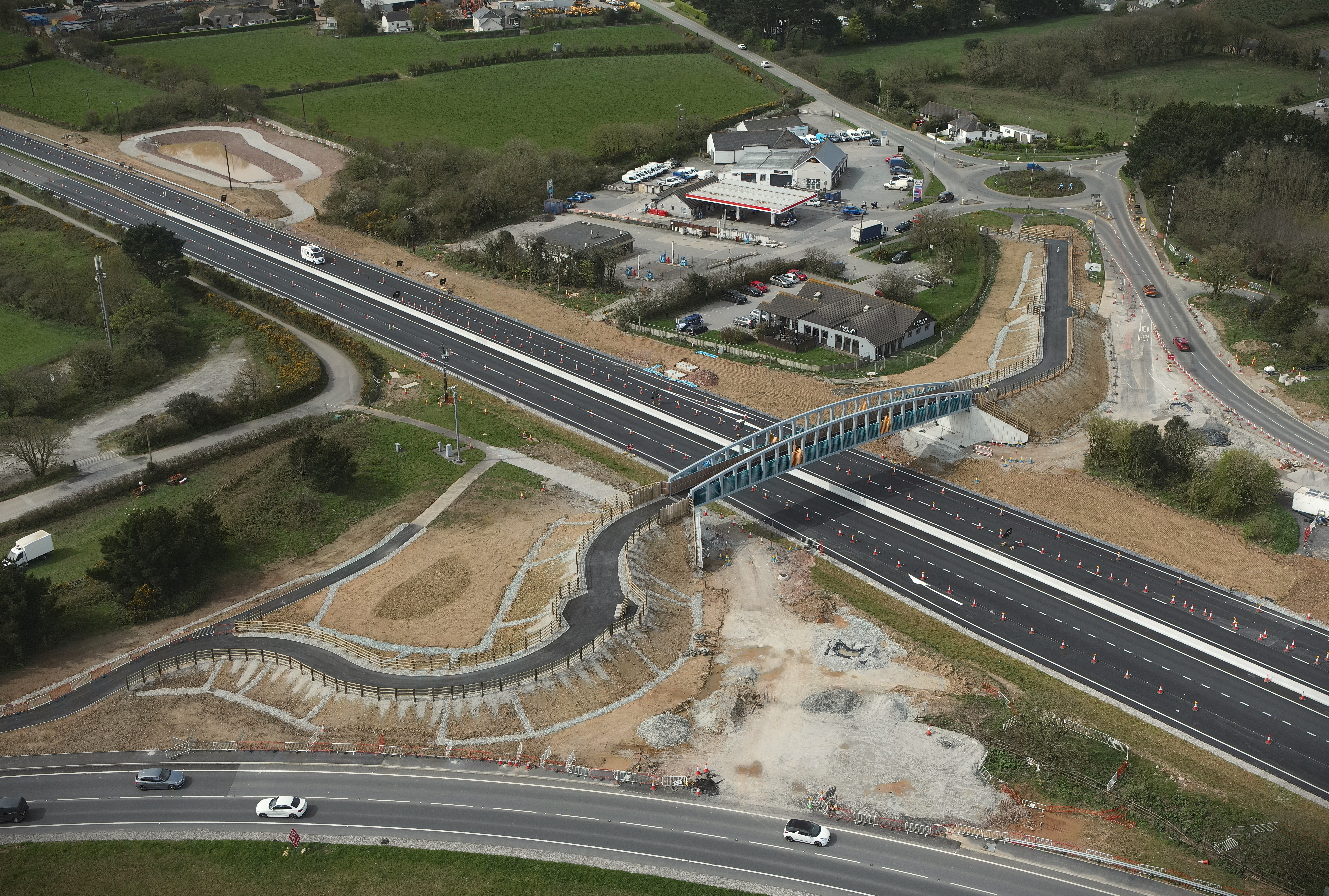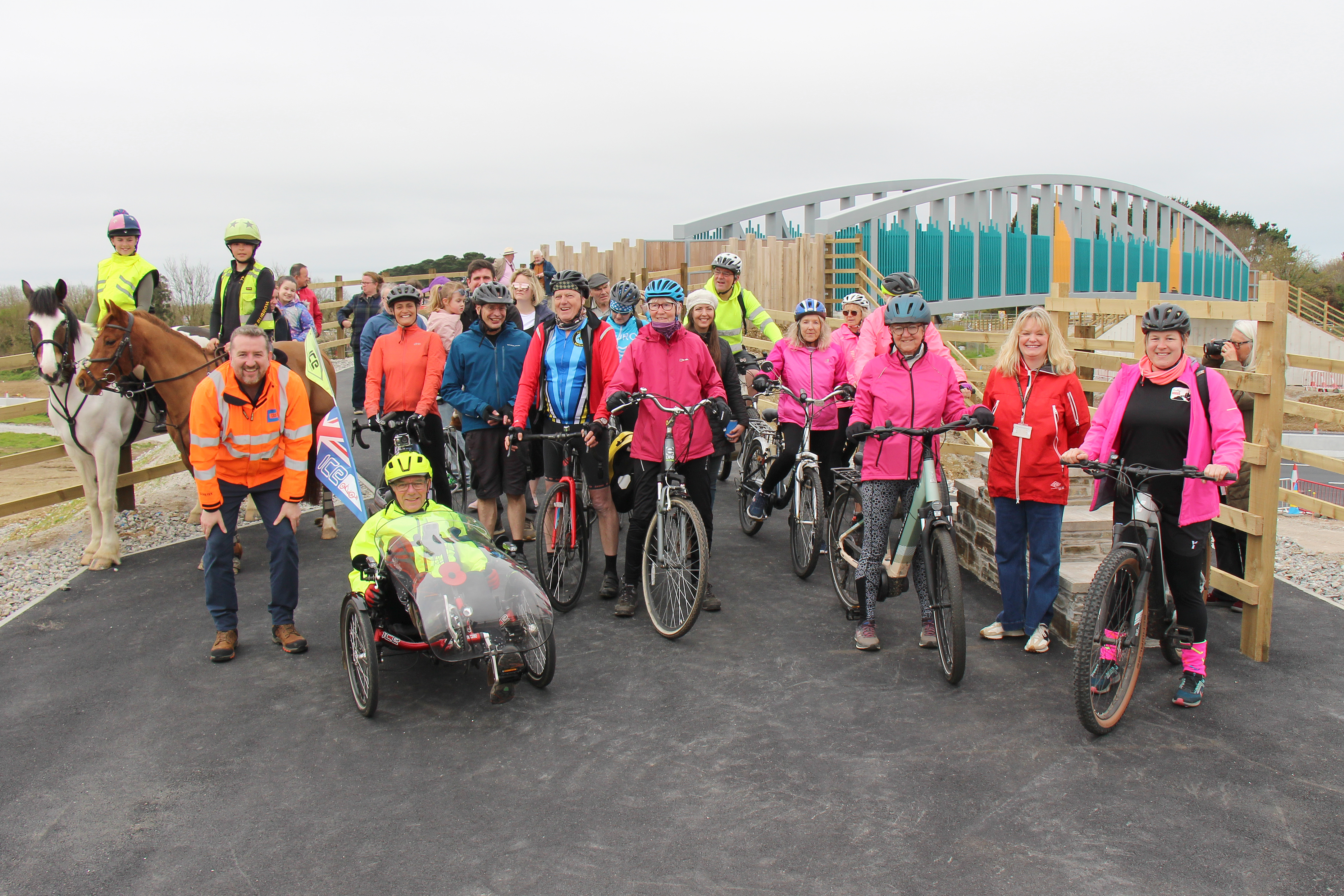
Chiverton Bridge
Sustainable delivery of a vital bridge scheme which brings a host of benefits to the local community, including opportunities for active travel and enhanced local connectivity, while completing a key stretch of the Saints Trail between St Agnes and Truro.
- Service 1
Cornwall Council
- Service 1
Detailed design
Planning and consents
Construction
- Service 1
2022-2024
- Service 1
- Service 1
We were appointed by Cornwall Council to provide the detailed design, construction and commission of a new traffic-free bridge over the A30, to be used by walkers, cyclists and horse-riders. The 48-metre Vierendeel steel truss bridge is a gamechanger for local connectivity, facilitating access to and from the Royal Cornwall Hospital, and creating new opportunities for active travel on the much-anticipated Saints Trail between Truro and St Agnes. As part of the wider Saints Trail scheme, the project was part funded by the European Regional Development Fund.
Key Benefits
- Achieved BREEAM Excellent rating.
- Saved approximately 200 tonnes of carbon dioxide (tCO2e) - a 30% reduction compared to the concept design.
- Creating habitats which will result will in nearly 220% Biodiversity Net Gain.
- Removed 18 tonnes of steel from the bridge design, equating to approximately 50 tCO2e.
- Maximised use of low carbon cement and repurposed excavated materials.
The bridge was campaigned for by the local community and we have worked closely with our customer, Cornwall Council, to deliver the full potential of the chosen design. The design was selected for the way it celebrates Cornish mining heritage and for working in sympathy with the landscape, as well as serving as a physical gateway to this part of South Cornwall. Our approach to planning, design and construction was in keeping with this ethos and honoured the ambition to provide much-needed new infrastructure, while celebrating its environment. Throughout the enabling works and bridge installation, we developed solutions to cut carbon emissions, minimise disruption to the community and ensure value for money.
There were three key pillars to our approach to sustainability, which was embedded in the project from the design phase: biodiversity net gain, reducing our carbon footprint and working in harmony with the local community.
Significant biodiversity net gain
The project's integration with the local environment extends beyond aesthetic considerations. The landscaping is coordinated with the A30 Chiverton to Carland Cross project and ensures a seamless transition between the natural and built environments.
Our collaborative and considerate landscape design is creating habitats for new species to replace the existing lower value habitats. These habitats, which include hedgerows, woodland and wildflower meadows, will result in a significant 218% Biodiversity Net Gain (BNG). The species have been selected for their proven track record of growing within the locality, their reliability and form, their contribution to seasonal interest and their boost to biodiversity. As well as helping to integrate the new bridge with the landscape, the increased biodiversity will also mitigate the impacts of climate change. The provision of bird and bat boxes provides suitable long-term habitat for bats and birds and supports the wider local ecosystem of fauna including hedgehogs. A detailed Landscape and Ecology Management Plan has been put in place to monitor and manage the establishment of habitats to ensure the delivery of BNG.
Reducing carbon emissions by 30%
Engaging in early design reviews and fostering collaboration among all stakeholders was crucial for identifying carbon hot spots and focusing efforts on the most impactful elements of the design. This proactive approach allowed for the integration of sustainable practices from the outset, ensuring that the project did not merely meet but exceeded the initial targets set for carbon reduction. This collaborative effort resulted in a notable reduction of CO2 emissions by 30% from the concept design phase.
In accordance with our Materials Mandate, which is a key focus of our Climate Change Action Plan, we designed out carbon and used low carbon materials wherever possible. In collaboration with our supply chain partner, NuSteel, we held a series of workshops to explore how we could maintain the integrity of the bridge while reducing the amount of steel required. Together, we were able to identify an 18-tonne reduction in steel usage; the equivalent of saving approximately 50 tonnes of CO2 emissions and cutting the cost of the overall steel structure by £36k, underlining the project’s commitment to sustainability and efficient use of resources.
We used low-carbon cement for the bridge abutments and wing walls, and we retained 107m3 of material in situ during the earthworks, which would have otherwise been excavated and removed from the site, saving on additional transportation (removing lorries from the local roads) and disposal cost and associated carbon emissions. We also repurposed the biproducts created when China Clay (a material typical of the South West) is produced as a substitute for primary aggregate.
Our commitment to sustainability required an agile approach to our ways of working. We sequenced the construction programme to align with our materials use; one such example would be our choice to use Ground Granulated Blast-furnace Slag (GGBS) as a cement substitute to replace up to 75% of the cement in the concrete. This form of low carbon concrete cures more slowly, so we allowed for an extra two days for this to happen. As this had been proactively planned from the outset, it had no negative impact on the programme schedule.
Social value benefits to the local community
In addition to improving access to the Royal Cornwall Hospital, the new bridge has also improved accessibility to local services, including businesses, shops and schools.
With the community at the heart of the project from the outset, the construction programme was designed to minimise disruption to residents and road users. We phased works on the new bridge to align our activities with the A30 Chiverton to Carland Cross project, which meant that we could conduct key works on the bridge during existing closures planned by National Highways. The new steel bridge was lifted in on a weeknight, with the road open to traffic again just a few hours later.
Lastly, we knew how passionate local residents were about this scheme and we made sure to engage with them regularly, both formally and informally, so that they had the opportunity to provide feedback on our construction plan.
By prioritising carbon reduction, material efficiency, biodiversity enhancement and community involvement, the project serves as a model for future infrastructure projects. It showcases how innovative approaches and collaborative planning can lead to significant improvements in both performance and sustainability, which was recognised with the award of a BREEAM Excellent rating.
The Chiverton Bridge project has increased accessibility to a high-quality network of walking and cycle infrastructure. It will also encourage healthier lifestyle choices and contribute to the Council’s Climate Change emergency agenda, as well as delivering on various key strategies from the Cornwall Local Plan.

"Cornwall Council is immensely satisfied with the Chiverton Bridge project. Its completion not only exemplifies our commitment to sustainable infrastructure and active travel but also enhances community connectivity in a manner that respects and preserves our rich local heritage. This project has set a new standard for environmental and social responsibility in Cornwall."
Contact and social
Aviation and integrated transport
